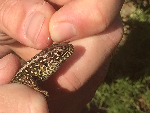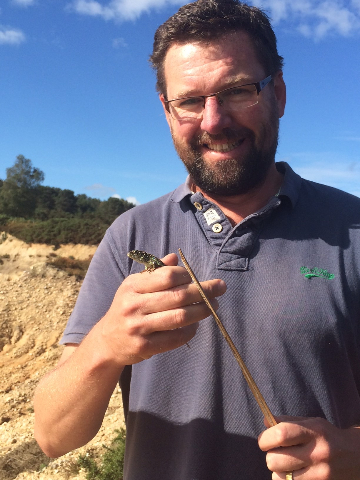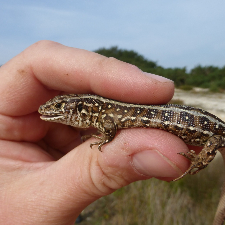As the days get shorter, this week in late September sees us pass the point of equal day and night length: the autumnal equinox. The spring and autumn equinoxes are busy times for reptiles in northern latitudes with pronounced seasons. The vernal (spring) equinox sees lots of activity following a long winter hibernation period. Males bask to encourage sperm production, then feed to get into breeding condition. Female emergence usually lags behind by a couple of weeks.
The autumnal equinox sees lots of pre-hibernation feeding; especially important for breeding females that have recently expended a lot of body mass on reproduction. It is widely believed that female sand lizards enter hibernation earlier than the males, and often in early September. But our experience is that adult female sand lizards can be active right through September. In fact, we are currently carrying out a licensed translocation in a Dorset sand quarry, and have seen quite a few female sand lizards in the last few days. It makes sense really, especially if some of them have laid two clutches, in May and August.
lizards in the last few days. It makes sense really, especially if some of them have laid two clutches, in May and August.

The period from late September through to October, and even early November, is also a time of much activity for young reptiles that have recently hatched or been born. Young lizards and snakes are born relatively late in the active season, and therefore must feed and grow as much as possible before hibernating through several months of winter; no mean feat for a tiny hatchling or neonate lizard.
Today (24th September 2014) is day 6 of our capture exercise in Dorset. We noosed two adult males this m
Luckily the weather is set to cooperate with us for some time yet. A mixture of sunny periods and cloudy mild weather is good, especially as the nights aren't freezing yet. It means we can combine visual search, hand capture, noosing, and artificial refugia (small felt mats) to catch our lizards, from 10am till 4.30pm. When the sun is out, lizards are still very mobile, especially the young while huntinf. Adults are still hunting too though, and can be observed eating craneflies and spiders. Sand lizards readily sit on our felts, which helps locate and catch them. When it's cloudy, they take refuge under our felts; which also makes them easier to catch.

